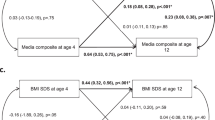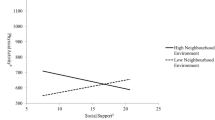Abstract
Background/Objectives:
Prior research indicates that features of the home environment (for example, televisions, exercise equipment) may be associated with obesity, but no prior study has examined objective features of the home food environment (for example, location of food) in combination with behavioral (for example, food purchasing), psychological (for example, self-efficacy) and social factors among obese adults. This study identified factors associated with obesity status from measures of home environment, food purchasing behavior, eating behavior and psychosocial functioning.
Subjects/Methods:
One hundred community-residing obese (mean body mass index (BMI)=36.8, s.e.=0.60) and nonobese (mean BMI=23.7, s.e.=0.57) adults (mean age=42.7, s.e.=1.50; range=20–78 years) completed an observational study with 2-h home interview/assessment and 2-week follow-up evaluation of food purchases and physical activity. Data were analyzed with analysis of variance and logistic regression, controlling for sex.
Results:
Univariate analyses revealed that homes of obese individuals had less healthy food available than homes of nonobese (F(1,97)=6.49, P=0.012), with food distributed across a greater number of highly visible locations (F(1,96)=6.20, P=0.01). Although there was no group difference in household income or size, obese individuals reported greater food insecurity (F(1,97)=9.70, P<0.001), more reliance on fast food (F(1,97)=7.63, P=0.01) and more long-term food storage capacity in number of refrigerators (F(1,97)=3.79, P=0.05) and freezers (F(1,97)=5.11, P=0.03). Obese individuals also reported greater depressive symptoms (F(1,97)=10.41, P=0.002) and lower ability to control eating in various situations (F(1,97)=20.62, P<0.001). Multiple logistic regression revealed that obesity status was associated with lower self-esteem (odds ratio (OR) 0.58, P=0.011), less healthy food consumption (OR 0.94, P=0.048) and more food available in the home (OR 1.04, P=0.036).
Conclusions:
The overall pattern of results reflected that home food environment and psychosocial functioning of obese individuals differed in meaningful ways from that of nonobese individuals. In particular, lower self-esteem may be an important psychosocial aspect of obesity, especially in the context of greater food consumption and food storage/availability.
This is a preview of subscription content, access via your institution
Access options
Subscribe to this journal
Receive 12 print issues and online access
$259.00 per year
only $21.58 per issue
Buy this article
- Purchase on Springer Link
- Instant access to full article PDF
Prices may be subject to local taxes which are calculated during checkout
Similar content being viewed by others

References
Mokdad AH, Bowman BA, Ford ES, Vinicor F, Marks JS, Kopland JP . The continuing epidemics of obesity and diabetes in the United States. JAMA 2001; 286: 1195–1200.
Rahmouni K, Correia MLG, Haynes WG, Mark AL . Obesity-associated hypertension: New insights into mechanisms. Hypertens 2005; 45: 9–14.
Kushner R, Foster G . Obesity and quality of life. Nutr 2000; 16: 947–952.
Kolotkin RL, Crosby RD, Kosloski KD, Williams GR . Development of a brief measure to assess quality of life in obesity. Obes Res 2001; 9: 102–111.
Fontaine KR, Barofsky I . Obesity and health-related quality of life. Obesity Rev 2001; 2: 173–182.
Roberts RE, Deleger S, Strawbridge WJ, Kaplan GA . Prospective association between obesity and depression: Evidence from the Alameda County Study. Int J Obes 2003; 27: 514–521.
Hill J O, Wyatt HR, Reed GW, Peters JC . Obesity and the environment: Where do we go from here? Sci 2003; 299: 853–855.
Campbell KJ, Crawford DA, Ball K . Family food environment and dietary behaviors likely to promote fatness in 5-6 year-old children. Int J Obes 2006; 30: 1272–1280.
Golan M, Crow S . Targeting parents exclusively in the treatment of childhood obesity: long-term results. Obes Res 2004; 12: 357–361.
Rosenkranz RR, Dzewaltowski DA . Model of the home food environment pertaining to childhood obesity. Nutr Rev 2008; 66: 123–140.
Booth SL, Sallis JF, Ritenbaugh C, Hill JO, Birch LL, Frank LD et al. Environmental and societal factors affect food choice and physical activity: rationale, influences, and leverage points. Nutr Rev 2001; 59: S21–S39.
Phelan S, Liu T, Gorin A, Lowe M, Hogan J, Fava J et al. What distinguishes weight-loss maintainers from the treatment-seeking obese? Analysis of environmental, behavioral, and psychosocial variables in diverse populations. Ann Behav Med 2009; 38: 94–104.
Gorin AA, Raynor HA, Fava J, Maguire K, Robichaud E, Trautvetter J et al. Randomized controlled trial of a comprehensive home environment-focused weight-loss program for adults. Health Psychol 2013; 32: 128–137.
Gorin AA, Phelan S, Raynor H, Wing RR . Home food and exercise environments of normal-weight and overweight adults. Am J Health Behav 2011; 35: 618–626.
Hill AJ, Williams J . Psychological health in a non-clinical sample of obese women. Int J Obesity 1998; 22: 578–583.
Richman RM, Loughnan GT, Droulers AM, Steinbeck KS, Caterson ID . Self-efficacy in relation to eating behavior among obese and non-obese women. Int J Obesity 2001; 25: 907–913.
McCullough ML, Feskanich D, Stampfer MJ, Giovannucci EL, Rimm EB, Hu FB et al. Diet quality and major chronic disease risk in men and women: Moving toward improved dietary guidance. Am J Clin Nutr 2002; 76: 1261–1271.
Fulkerson JA, Nelson MC, Lytle L, Moe S, Heitzler C, Pasch KE . The validation of a home food inventory. Int J Behav Nutr Phys Act 2008; 5: 55.
Miller C, Edwards L . Development and validation of a shelf inventory to evaluate household food purchases among older adults with diabetes mellitus. J Nutr Educ Behav 2002; 34: 261–267.
Sisk C, Sharkey JR, McIntosh WA, Anding J . Using multiple household food inventories to measure food availability in the home over 30 days: A pilot study. Nutr J 2010; 9: 19.
United States Department of Agriculture (September, 2012). U.S. household food security survey module: Three-stage design, with screeners http://www.ers.usda.gov/datafiles/Food_Security_in_the_United_States/Food_Security_Survey_Modules/hh2012.pdf.
Zigmond AS, Snaith RP . The hospital anxiety and depression scale. Acta Psychiatr Scand 1983; 67: 361–370.
Glynn SM, Ruderman AJ . The development and validation of an eating self-efficacy scale. Cognit Ther Res 1986; 10: 403–420.
Ware JE, Sherbourne CD . The MOS 36-item short form health survey (SF-36): I. conceptual framework and item selection. Med Care 1992; 30: 473–483.
Zimet GD, Dahlem NW, Zimet SG, Farley GK . The multidimensional scale of perceived social support. J Pers Assess 1988; 52: 30–41.
Buysse DJ, Reynolds CF, Monk TH, Berman SR, Kupfe D . Pittsburgh sleep quality index: a new instrument for psychiatric practice and research. Psychiatry Res 1989; 28: 193–213.
Blair SN, Haskell WL, Ho P, Paffenberger RS, Vranizan KM, Farquhar JW et al. Assessment of habitual physical activity by a seven-day recall in a community survey and controlled experiments. Am J Epidemiol 1985; 122: 794–804.
Townsend MS, Peerson J, Love B, Achterberg C, Murphy SP . Food insecurity is positively related to overweight in women. J Nutr 2001; 131: 1738–1745.
Luppino FS, de Wit LM, Bouvy PF, Stijnen T, Cuijpers P, Penninx BW et al. Overweight, obesity, and depression: A systematic review and meta-analysis of longitudinal studies. Arch Gen Psychiatry 2010; 67: 220–229.
Beccutia G, Pannaina S . Sleep and obesity. Curr Opin Clin Nutr Metab Care 2011; 14: 402–412.
Perneger TV . What's wrong with Bonferroni adjustments. Br Med J 1998; 316: 1236–1238.
Streiner DL, Norman GR . Correction for multiple testing: Is there a resolution? Chest 2011; 140: 16–18.
Foster GD, Wadden TA, Vogt RA, Brewer G . What is a reasonable weight loss? Patients' expectations and evaluations of obesity treatment outcomes. J Consult Clin Psychol 1997; 65: 79–85.
Acknowledgements
This work was supported by a grant from the Ohio State University Food Innovation Center and by Award Number Grant UL1TR001070 from the National Center for Advancing Translational Sciences, NIH.
Author information
Authors and Affiliations
Corresponding author
Ethics declarations
Competing interests
The authors declare no conflict of interest.
Rights and permissions
About this article
Cite this article
Emery, C., Olson, K., Lee, V. et al. Home environment and psychosocial predictors of obesity status among community-residing men and women. Int J Obes 39, 1401–1407 (2015). https://doi.org/10.1038/ijo.2015.70
Received:
Revised:
Accepted:
Published:
Issue Date:
DOI: https://doi.org/10.1038/ijo.2015.70
This article is cited by
-
The perceived role of food and eating among Turkish women with obesity: A qualitative analysis
Current Psychology (2023)
-
Reward-related eating, self-regulation, and weight change in pregnancy and postpartum: the Pregnancy Eating Attributes Study (PEAS)
International Journal of Obesity (2020)
-
The Relationship Between Food Insecurity, Dietary Patterns, and Obesity
Current Nutrition Reports (2016)


